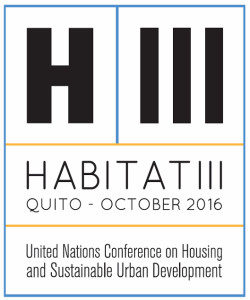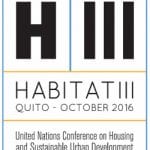by Stephen Wheeler
During the first two weeks of June 1996 more than 12,000 urban planners, government officials and activists converged on Istanbul for the United Nation’s Conference on Human Settlements, also known as Habitat II or the “City Summit.” This landmark event had twin themes: “sustainable human settlements development” and “adequate shelter for all.”
While the results were mixed, Habitat II provided an important opportunity for participants from around the world to share strategies on current urban problems and more sustainable forms of development.
At the core of the event were official negotiating sessions attended by delegations from 171 nations. Representatives of accredited non-governmental organizations (NGOs) were also allowed to attend. The outcome was an Istanbul Declaration listing principles and goals of urban development, as well as a Habitat Agenda, or Global Plan of Action. Despite sometimes convoluted language these documents affirm many principles of sustainable urban development, and emphasize a global right to housing, women’s rights and grass-roots empowerment.
A second main element of Habitat II was the NGO Forum, held at an Istanbul Technical University building a short distance away. Nearly 3,000 NGOs attended from all over the world, including many from the host country Turkey. Hundreds of groups presented material at booths or tables. The forum also featured hundreds of seminars on topics ranging from gender in development to use of GIS computer mapping.
A third focus of activity was the enormous Best Practices Exhibition held about a mile away at renovated warehouse buildings on the Istanbul waterfront. The Exhibition featured displays of some 600 projects from 90 nations. Some “best practices” such as monolithic new towns in China were highly questionable examples of sustainable urban development, and other exhibits seemed dominated more by national or corporate boosterism than a commitment to sustainability. Still, the exhibition featured impressive displays from countries such as Germany, Austria, Sweden, the Netherlands, and Indonesia, as well as numerous presentations and parallel one-day events. These events included the first showcasing of fledgling “sustainable city programs” in dozens of municipalities worldwide.
A fourth series of events consisted of 10 one-day forums on development topics held at the luxurious Marmara Hotel, which dominates the skyline of modern Istanbul. Although mainstream agencies sponsored many of these forums, most acknowledged that dramatically new approaches to urban development are needed. The Transportation Forum, for example, highlighted the need to move away from automobiles, improve public transit, coordinate land use with transit, and redo transportation pricing structures. Even Mercedes Benz Vice President J. Scharwachter, representing the event’s financial sponsor, called for de-emphasizing the role of the automobile in transportation.
Steps Toward Sustainable Development
It is an open question whether much progress has been made on urban issues since the Habitat I conference was held in Vancouver 20 years ago. At that optimistic event 132 nations agreed to an ambitious set of 64 goals, including steps toward insuring equity and preventing land speculation in urban areas. But mid-70s idealism then ran into the hard realities of Reaganism, Thatcherism, and structural adjustment. Few if any Habitat I goals were met. For example, Habitat I called for all the world’s urban residents to have access to safe drinking water by 1990. But by 1994 600 million urban dwellers still lacked this basic necessity.
The atmosphere around Habitat II this year was far more cautious. Few people spoke of setting such ambitious targets. Yet it was clear that progress has been made at least on some fronts:
There is much broader global understanding of the need for development which meets long-term environment and social goals as well as economic ones. Multilateral and bilateral aid agencies are committing themselves to sustainable development, and sustainable city programs and networks are being established worldwide.
Gender issues are finally getting the attention they deserve. Most nations now recognize the need to ensure women’s equality and opportunity, and the important role of women in sustainable development.
Whereas Habitat I emphasized top-down government planning, there is now a realization that change must involve all sectors of society. In particular the institutions of “civil society” are taking a much more active role, as a growing variety of grassroots groups pursue small-scaled, participatory development projects using appropriate technology.
A number of methodologies are emerging to help governments plan for sustainability. These include Green Plans, Agenda 21 Plans, Sustainable City Plans; indicators of sustainable development; and forums for sharing Best Practices internationally.
Much progress has been made in specific areas such as making buildings more energy efficient, reducing air pollution, pedestrianizing urban downtowns, and developing procedures for restoring wetlands and contaminated urban land.
Remaining Issues
Though consensus is slowly emerging on many elements of healthy cities (compact urban form and transportation systems that do not rely on the automobile, for example), the obstacles to sustainable urban development are still mindboggling.
One main quandary has to do the scale and pace of development. Rapid, large-scale development is occurring the world over, whether in the form of modernist high-rise housing projects in Turkey or China or 3000-home subdivisions in the U.S. Is development at such a large scale desirable or sustainable? If it leads to the sort of monotonous, depersonalized landscapes now spreading around many of the world’s cities, the answer is probably no. The trick will be to find more incremental styles of development that can house large numbers of people within more diverse, adaptable, human-scale communities. A housing economics that supports small-scale, incremental development will also need to be nurtured.
Ironically, “informal” settlements may hold some of the answer. These are communities in which recent migrants build housing for themselves without legal title to land. Informal developments now account for the majority of new housing in many Third World cities, including Istanbul. They vary greatly in different parts of the world, and contain a wide range of housing, some of it very solid and well-built.
Many of the older informal communities around Istanbul are indistinguishable from other areas of the city and have had their land titles legalized by the government. Visually they appear to offer far more attractive, diverse, and community-oriented urban fabrics than large master planned housing tracts. The challenge may be to combine the entrepreneurial spirit and incremental style of informal settlements with sufficient advance planning and guidance to preserve land for parks and community facilities and ensure availability of transportation, water, sewage and electricity.
One glaringly obvious problem at Habitat II was the unwillingness of the developed nations, particularly the United States, to address the deficiencies of the suburban model of development and the more general issue of First World over-consumption. This is a particular problem since many Third World nations are copying American-style suburbs and lifestyles. Until the rich nations are willing to address issues of consumption and equity, there is likely to be little overall global progress towards sustainability.
Many speakers at conference events talked about “getting the prices right” — that is, reworking economics so that polluting companies and automobile users, for example, pay their full cost to society. However, it is clear that much of the global economic order has been built upon having the prices wrong, and benefits from them continuing to be so. Unfortunately, few business leaders were present at Habitat II to indicate how the emerging global economy can redo its internal accounting to put broader social and environmental goods ahead of private gain.
Regional planning was another under-emphasized topic at Habitat II. Such planning is urgently needed to constrain suburban sprawl and put in place transportation frameworks that de-emphasize the automobile. Two positive examples were provided by Frankfurt, Germany and Vienna, Austria. Frankfurt has just reaffirmed its commitment to a strong greenbelt around the city and is successfully converting an abandoned air force base into a mixed-use community. Vienna has adopted a strong regional plan which calls for channeling growth along several transit corridors out from the central city.
Conclusion
What overall lessons can be drawn from Habitat II? For one thing, that sustainable urban development will not come quickly or easily. For another, that international summit conferences alone will not solve the world’s problems. Little progress has been made toward fulfilling many goals set at the 1992 Earth Summit in Rio and the 1995 Women’s Summit in Beijing, let alone Habitat I, and a great deal of effort was expended at Habitat II just to protect language agreed to at the previous 1990s conferences.
On the other hand, many initiatives showcased at Habitat II point to a determined effort in many parts of the world to pursue concepts such as sustainable development. This is a profoundly hopeful sign. The real work for conference participants now lies at home, to reform national and local governments so that they can more effectively respond to urban problems, to change our own lifestyles, activities, and consumption patterns, and to develop more fully the vision of sustainable cities.







